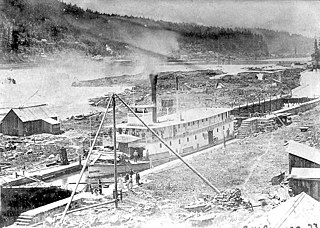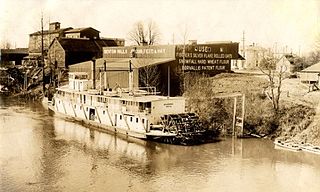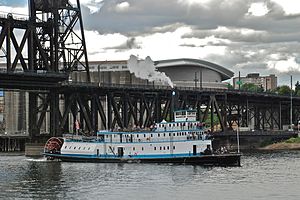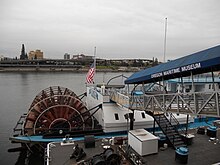The Shaver Transportation Company is an inland water freight transportation company based in Portland, Oregon, United States. The company was founded in 1880 and played a major role in the development of freight transport in the Portland area and along the Columbia.

Many steamboats operated on the Columbia River and its tributaries, in the Pacific Northwest region of North America, from about 1850 to 1981. Major tributaries of the Columbia that formed steamboat routes included the Willamette and Snake rivers. Navigation was impractical between the Snake River and the Canada–US border, due to several rapids, but steamboats also operated along the Wenatchee Reach of the Columbia, in northern Washington, and on the Arrow Lakes of southern British Columbia.

The Willamette River flows northwards down the Willamette Valley until it meets the Columbia River at a point 101 miles from the Pacific Ocean, in the U.S. state of Oregon.

The history of steamboats on the Oregon Coast begins in the late 19th century. Before the development of modern road and rail networks, transportation on the coast of Oregon was largely water-borne. This article focuses on inland steamboats and similar craft operating in, from south to north on the coast: Rogue River, Coquille River, Coos Bay, Umpqua River, Siuslaw Bay, Yaquina Bay, Siletz River, and Tillamook Bay. The boats were all very small, nothing like the big sternwheelers and propeller boats that ran on the Columbia River or Puget Sound. There were many of them, however, and they came to be known as the "mosquito fleet."

The Coquille River starts in the Siskiyou National Forest and flows hundreds of miles through the Coquille Valley on its way to the Pacific Ocean. Bandon, Oregon, sits at the mouth of the Coquille River on the Pacific Ocean. Before the era of railroads and later, automobiles, the steamboats on the Coquille River were the major mode of transportation from Bandon to Coquille and Myrtle Point in southern Coos County, Oregon, United States.

The steamship Altona operated from 1890 to 1907 on the Willamette River in the U.S. state of Oregon. In 1907, she was transferred to Alaska.

The Greyhound was an express passenger steamer that operated from the 1890s to about 1915 on Puget Sound in Washington, United States. This vessel, commonly known as the Hound, the Pup, or the Dog, was of unusual design, having small upper works, but an enormous sternwheel. Unlike many sternwheelers, she was not intended for a dual role as passenger and freighter, but was purpose-built to carry mostly passengers on express runs.

Willamette Chief was a sternwheel steamboat built in 1874 for the Willamette River Navigation Company.

Kootenai was a sternwheel steamboat that ran on the Arrow Lakes in British Columbia from 1885 to 1895. Kootenai was the second sternwheeler to run on the Arrow Lakes. This vessel should not be confused with the similarly named Kootenay, an 1897 sternwheeler that also ran on the Arrow Lakes.

Echo was a sternwheel steamboat that operated on the Willamette River from about 1865 to 1873 and was one of the first steamboats to carry what was then considered a large cargo out of Eugene, Oregon.

The river sternwheeler Ramona operated from 1892 to 1908 on the Willamette River in Oregon, on the Stikine River running from Wrangell, Alaska into British Columbia, and the Fraser River, in British Columbia. This vessel should not be confused with the coastal steamship Ramona which also ran in Alaskan waters.

Governor Grover was a sternwheel steamboat that ran on the Willamette River during the 1870s. Because of the completion of the Willamette Locks in late 1872, it was possible for vessels such as Governor Grover to be built in Portland, Oregon and then readily navigate the Willamette above Willamette Falls.

Since the early 1980s, several non-steam-powered sternwheel riverboats have been built and operated on major waterways in the U.S. state of Oregon, primarily the Willamette and Columbia Rivers, as river cruise ships used for tourism. Although configured as sternwheelers, they are not paddle steamers, but rather are motor vessels that are only replicas of paddle steamers. They are powered instead by diesel engines. The Lurdine was, when launched in 1983, "the first passenger-carrying sternwheeler in decades to [operate] on the Columbia River". In the case of the 1983-built M.V. Columbia Gorge, the construction and operation of a tourist sternwheeler was led by local government officials who viewed the idea as potentially being a major tourist attraction, giving an economic boost to their area, Cascade Locks, Oregon.

Emma Hayward commonly called the Hayward, was a steamboat that served in the Pacific Northwest. This vessel was once one of the finest and fastest steamboats on the Columbia River and Puget Sound. As newer vessels came into service, Emma Hayward was relegated to secondary roles, and, by 1891, was converted into a Columbia river tow boat.

Grahamona was a sternwheel steamboat built in 1912 for the Oregon City Transportation Company, commonly known as the Yellow Stack Line. Grahamona was specially designed to serve on the shallow waters of the upper Willamette River. It was one of the largest steamboats ever to operate on the upper Willamette. In 1920, Grahamona was sold and the name was changed to Northwestern. In 1939, the vessel was sold again, and transferred to Alaska for service on the Kuskokwim River.

Elwood was a sternwheel steamboat which was built to operate on the Willamette River, in Oregon, but which later operated on the Lewis River in Washington, the Stikine River in Canada, and on Puget Sound. The name of this vessel is sometimes seen spelled "Ellwood". Elwood is probably best known for an incident in 1893, when it was approaching the Madison Street Bridge over the Willamette River in Portland, Oregon. The bridge swung open to allow the steamer to pass. However, a streetcar coming in from the east end of the bridge failed to notice the bridge was open, and ran off into the river in the Madison Street Bridge disaster.

Jennie Clark, also seen spelled Jenny Clark, was the first sternwheel-driven steamboat to operate on the rivers of the Pacific Northwest, including British Columbia. This vessel was commonly known as the Jennie when it was in service. The design of the Jennie Clark set a pattern for all future sternwheel steamboats built in the Pacific Northwest and in British Columbia.

Telephone was a sternwheel-driven steamboat built in 1884 by Captain Uriah Bonsor "U.B." Scott for service on the Columbia River. Reputedly the fastest steamboat in the world in its time, Telephone served on the Columbia River and San Francisco Bay. Telephone was rebuilt at least twice. The first time was after a fire in 1887 which nearly destroyed the vessel. The reconstructed and much larger second vessel was sometimes referred to as Telephone No. 2. The third vessel, Telephone No. 3, built in 1903 and using components from the second steamer was larger but little used during its time on the Columbia river.

Orient was a light-draft sternwheel-driven steamboat built in 1875 for the Willamette River Transportation Company, a concern owned by pioneer businessman Ben Holladay. Shortly after its completion, it was acquired by the Oregon Steam Navigation Company. Orient was a near-twin vessel of a steamer built at the same time, the Occident.

Governor Newell was a sternwheel-driven steamboat that operated from 1883 to 1902 in the Pacific Northwest.





















